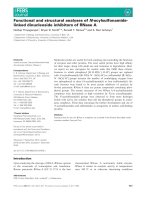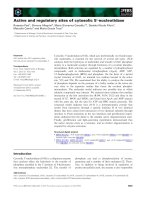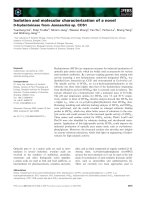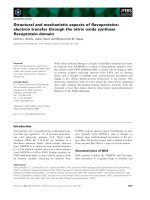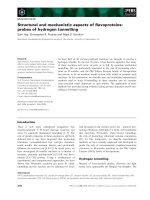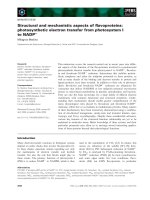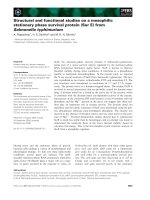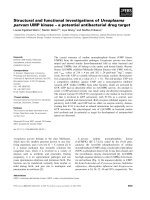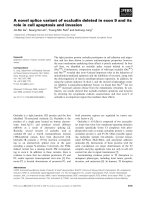Báo cáo khoa học: " Direct and indirect measurement of somatic cell count as indicator of intramammary infection in dairy goats" ppt
Bạn đang xem bản rút gọn của tài liệu. Xem và tải ngay bản đầy đủ của tài liệu tại đây (253.06 KB, 5 trang )
RESEARCH Open Access
Direct and indirect measurement of somatic cell
count as indicator of intramammary infection in
dairy goats
Ylva Persson
1*
, Ida Olofsson
2
Abstract
Background: Mastitis is the most important and costly disease in dairy goat production. Subclinical mastitis is
common in goats and is mainly caused by contagious bacteria. Several methods to diagnose subclinical mastitis
are avai lable. In this study indirect measurement of somatic cell count (SCC) by California Mastitis Test (CMT) and
direct measurement of SCC using a portable deLaval cell counter (DCC) are evaluated. Swedish goat farmers would
primarily benefit from diagno stic methods that can be used at the farm. The purpose of the study was to evaluate
SCC measured by CMT and DCC as possible markers for intramammary infection (IMI) in goats without clinical
symptoms of mastitis. Moreover to see how well indirect measurement of SCC (CMT) corresponded to direct
measurement of SCC (DCC).
Method: Udder half milk samples were collected once from dairy goats (n = 111), in five different farms in
Northern and Central Sweden. Only clinically healthy animals were included in the study. All goats were in mid to
late lactation at sampling. Milk samples were analyzed for SCC by CMT and DCC at the farm, and for bacterial
growth at the laboratory.
Results: Intramammary infection, defined as growth of udder pathogens, was found in 39 (18%) of the milk
samples. No growth was found in 180 (81%) samples while 3 (1%) samples were contaminated. The most
frequently isolated bacterial species was coagulase negative staphylococci (CNS) (72% of all isolates), followed by
Staphylococcus aureus (23% of all isolates). Somatic cell count measured by DCC was strongly (p = 0.000)
associated with bacterial growth. There was also a very strong association between CMT and bacterial growth. CMT
1 was associated with freedom of IMI while CMT ≥2 was associated with IMI. Indirect measurement of SCC by CMT
was well correlated with SCC measured by DCC.
Conclusions: According to the results, SCC measured with CMT or DCC can predict udder infection in goats, and
CMT can be used as a predictor of the SCC.
Background
Mastitis is the most important and costly disease in
dairy goat production in the Nordic countries (Indrebö
unpubl. 1987) and therefore important to diagnose and
control. While clinical mastitis is rather easy to detect,
animals with subclinical mastitis are often difficult to
find since there is a lack of reliable diagnostic metho ds;
especially at farm level [1]. Subclinical mastitis is an
important disease since it can lead to reduced milk
production, decreased milk quality for dairy purposes
and poor milk hygiene; especially important when
unpasteurized milk is used for cheese production.
Subclinical mastitis in goats is common [2] and is
mainly caused by bacteria; coagulase negative staphylo-
cocci (CNS) and Staphylococcus aureus (S. aureus) being
the most common pathogens ([3], [4], Mörk et al.,
unpubl.2007).Undiagnosedsubclinical mastitis might
lead to poor herd udder health due to shedding of
udder pathogens from subclinical intramammary infec-
tions (IMI). Presence of IMI may be diagnosed indirectly
by measuring markers of inflammation in milk. The
most important marker is somatic cell count (SCC),
* Correspondence:
1
Department of Animal Health and Antimicrobial Strategies, National
Veterinary Institute/Swedish Dairy Association, Uppsala, Sweden
Full list of author information is available at the end of the article
Persson and Olofsson Acta Veterinaria Scandinavica 2011, 53:15
/>© 2011 Persson and Olofsson; licensee BioMed Central Ltd. This is an Open Access article distributed under the terms of the Creative
Commons Attribution License ( which permits unrestricted us e, distribution, and
reproduction in any medium, provi ded the original work is properly cited.
which can be measured by both indirect and direct
methods. Swedish goat farmers would primarily benefit
from diagnostic methods that can be used at the farm,
since goat production in Sweden is of a fairly low scale.
Somatic cell count is the most widely used indicator
of udder health in cow, sheep and goat milk, but unfor-
tunately SCC is difficult to interpret in goats. Compared
to sheep and cows, SCC in goat milk is relatively high
also in the healthy udder and it increases throughout
the lactation and also with parity [5]. There is also a
great variation in SCC among farms and among indivi-
duals [6]. However, elevated SCC is, according to Pou-
trel et al. [7], mainly a response to infection. Therefore,
measurement of SCC seems likely to be a reliable way
to detect goats with IMI. In goats, the milk SCC is more
influenced by normal physiological factors than in cows.
Therefore, standards for SCC in milk established for
cows are not appropriate for goats. Though, to be able
to eliminate and prevent goat IMI by using SCC in
milk, there is a need for standards and guidelines appro-
priate for goats. A reliable direct method of measuring
SCC is by using an automatic c ell counter; either by
using a portable cell counter at the farm, or by sending
milk samples to a laboratory for measurement in, for
example, a Fossomatic cell counter. The adva ntage with
an automatic cell counter is tha t it is objective and
accurate. Disadvantages are that it can be time consum-
ing if sent to a laboratory or costly as expensive equip-
ment is required when used at the farm.
California Mastitis Test (CMT) is a common indirect
method of measuring SCC in cows, but some authors
claim that CMT is an unreliable method for diagnosing
IMI in goats [4], [6]. Other studies, however, report
that CMT may be useful for detection of healthy
udders [8,9]. The main advantages with CMT are that
it is quick, cheap and simple and that it is an “ anima l-
side” test.
ThepurposeofthestudywastoevaluateSCCmea-
sured with CMT and a portable automatic cell counter
(DeLavals cell counter; DCC [10 ]) as a possible marker
for IMI in goats without clinical signs of mastitis.
Another aim was to evaluate how well the CMT and
DCC results agreed with each other.
Methods
Farms and animals
Dairy goats (n = 111), mainly of the Swedish landrace
breed, in five different farms (28-165 goats) in Northern
and Central Sweden were sampled once in late summer
2008 by the same person. Four farms were sampled at
morning milking and one at evening milking. Only clini-
cally healthy animals without changes in udder consis-
tency or milk appearance were included in the study.
All goats were in mid to late lactation at sampling.
Milk sampling and measurement of SCC
All milk samples were collected immediately before
machine milking. Milk were tested by CMT and graded
from 1 to 5. The scores are r anked according to an
increase in viscosity, where the highest viscosity
(CMT 5) is more or less correlated to the highest SCC.
An aseptic milk sample was then collected from each
udder half and sent to the National Veterinary Institute
for bacteriological analysis. Milk from each udder half
was also collected in test tubes for further cell counting.
Milk aliquots were analyzed at the farm the same
day with the DCC (DeLaval International AB, Tumba,
Sweden [10]).
Bacteriological examinations
Bacteriological analysis was performed according to
accredited routines at the National Veterinary Institute,
Uppsala, Sweden. Milk samples (10 μl) were cultured on
blood (5%) agar plates, which were incubated at 37 °C
for 16-24 h, and re-evaluated at 48 h. Growth on the
plates was confirmed by additional laboratory tests in
accordance with the routines at the laboratory. Staphylo-
coccus aureus (S. aureus) was identified by means of
typical colony morphology, a-andb-hemolysis, or by
coagulase reaction (coagulase-positive) when typical
hemolysis zones were not present. Coagulase-negative
staphylococci (CNS) were identified by typical colony
morphology and negative coagulase reacti on, but were
not further characterized for this paper. Streptococci
were determined by colony morphology and CAMP-
reaction, and 12 biochemical reactions (hippurate,
aesculine, salicine, sorbitol, mannitol, raffinose, lactose,
saccharose, inuline, trehalose, starch and glycerine) were
used for typing to the species leve l. A milk sample was
classified as positive if at least one colony-forming unit
(CFU) of S. aureus was isolated. For other agents, the
presence of at least three CFU was needed for positive
classification. Samples were classified as contaminated if
three or more bacterial types were isolated from one
milk sample and growth of a major udder pathogen was
not identified. If moderate to high growth of a major
udder pathogen was found in c ombination with a few
CFU of several contaminating spec ies the sample would
be diagnosed as positive for growth of the major udder
pathogen. I n addition, all isolates of staphylococci were
examined for betalactamase production by the ‘’clover-
leaf’’ method as described by Bryan and Godfrey [11].
Statistics
Statistical analyses were performed using R, version
2.7.2 [12].
Cohen’ s kappa coefficient was used to measure the
agreement between CMT and DCC (<0 No agreement,
0-0.2 Slight agreement, 0.2-0.4 Fair agreement, 0.4-0.6
Persson and Olofsson Acta Veterinaria Scandinavica 2011, 53:15
/>Page 2 of 5
Moderate agreement, 0.6-0.8 Substantial agreement,
0.8-1 Almost perfect agreement).
The performance of CMT and DCC as markers for
IMI was evaluated using multiple regression models,
withtheoccurrenceofIMIasthedependentvariable
(yes/no) and the particular marker, as well as age (when
appropriate), as covariates. In cases where compensation
for correlation within herds or individuals was needed,
Generalized Estimating Equations (GEE) were used to
estimate the models.
Youden’s index [13] was used to optimize t he cut-off
of the sensitivity and specificity test.
Results
Bacteriology and somatic cell count
Intramammary infection, defined as growth o f udder
pathogens, was found in 39 (18%) milk samples from 30
(27%) goats. No growth was found in 180 ( 81%) samples
while 3 (1%) samples were contaminated. The most fre-
quently isolated bacterial species was CNS followed by
S. aureus. Of the CNS, 27% was positive for betalactamase
production. A ll S. aureus isolates were negative for betalac-
tamase production. Nine goats had IMI in both udder
halves and three goats h ad different t ypes of IMI in the two
halves. For more detailed informati o n on b acterial findings,
see Table 1. The o verall arithmetic mea n SCC measured by
DCC, was 519 × 10
3
cells/ ml. Mean SCC of udder halves
with bacterial growth or freedom of bacteria were 711 ×
10
3
cells/ml and 481 × 10
3
cells/ml, respectively. The high-
est SCC (1010 × 10
3
cells/ml) was found in udders positive
for S. aureus. The percentage of different culture results
and corresponding SCC are given i n Table 1.
Comparison between SCC and bacteriology
Somatic cell counts measured with CMT and DCC were
both significantly associated (p = 0 .000 and p = 0.01
respectively) with IMI. CMT 1 was associated with free-
dom of IMI and CMT ≥2 was assoc iated with IMI. Data
on IMI at different CMT scores are shown i n Table 2.
Figure 1 shows the sensitivity and specificity of CMT as
an indic ator of IMI, for different CMT cut-offs. Figure 2
shows t he sensitivity and specificity for SCC measured
by DCC (SCC-DCC) as an indicator of IMI.
Comparison of SCC measured with CMT and DCC
Indirect measurement of SCC by using CMT had a sub-
stantial agreement (Cohen’s kappa coefficient = 0.64) to
SCC measured by DCC. Mean SCC-DCC for CMT 1
was 255 × 10
3
cells/ml, for CMT 2; 455 × 10
3
cells/ml,
for CMT 3; 1265 × 10
3
cells/ml, for CMT 4; 2249 × 10
3
cells/ml and for CMT 5, mean SCC-DCC was 6291 ×
10
3
cells/ml. See Figure 3 for relationship between CMT
and SCC.
Discussion
In this study, SCC could predict IMI in goats, measured
with indirect (CMT) or direct (DCC) methods.
Only 18% of all udder halves had IMI in the present
study. This is lower than in other studies, where the
proportion of udder halves with subclini cal IMI in goats
ranged from 23 to 70% [1,14]. The lower proportion of
IMI in this study might be the result of good udder
health in the sampled herds. It could also be due to
false negative bacterial findings as the goats were only
sampled once in this study. For more accurate results,
sampling should be repeated at two o r more occasions.
In general, Swedish goats have a good health status with
few probl ems with infectious diseases. Sweden also has
rather small herds which, to some extent, could explain
the good udder health. High stocking density, particu-
larly in intensively managed herds, may be associated
with large concentrations of microorganisms [4]. In this
study, the main pathogen group in infected udder halves
wasCNS.Thisisinagreementwithotherstudieson
subclinical mastitis in goats [15], [1,4,16].
The mean SCC, measured by DCC, of uninfected
udder halves was 478 × 10
3
cells/ml. Other authors have
reported both lower and higher SCC in goats without
IMI [5], [17]. In future studies, it would be interesting
to measure SCC throughout the lactation, since SCC in
Table 1 Culture Results and Corresponding Milk SCC (DCC) and CMT Scores in 222 Udder Halves
Culture results % of all % of positive culture Mean SCC (SD) (1000/ml) Median CMT
S. aureus n=9 4 23 1010 (1690) 2
CNS n = 28 13 72 651 (700) 2
S. dysgalactiae n=2 1 5 200 (54) 1
No growth n = 180 81 481 (713) 1
Contaminated sample n = 3 1 281 (21) 1
All n = 222 519 (768) 1
Table 2 Number of samples with bacterial and no growth
at different CMT scores
Growth of bacteria CMT 1 CMT 2 CMT 3 CMT 4 CMT 5
Yes 18 12 7 1 1
No 111 44 22 2 1
Persson and Olofsson Acta Veterinaria Scandinavica 2011, 53:15
/>Page 3 of 5
goats can differ markedly between early and late lacta-
tion. Goats infected with S. aureus had the highest SCC,
which is in line with other studies [18], [19].
Somatic cell count measured by CMT agreed with
SCC measured with DCC, which is in agreement with
other studies [20], [8], [9]. It was also concluded that
CMT could predict IMI better than at random, which is
in line with a recent study [14]. Goat farmers would
therefore benefit from using CMT in their daily work at
the farm. CMT is an easy and cheap method, which can
be performed as a “goat-side” test. In larger herds, DCC
may be a good, but more expensive, alternative for more
objective measures of SCC.
Conclusions
According to these results, SCC measured by CMT or
DCC can predict IMI of goats. Moreover, CMT is a
good predictor of SCC. Thus, goat farmers can be
recommended to use CMT as a “goat-side ” test in order
to find IMI in goats with no clinical symptoms of
mastitis.
Acknowledgements
Many thanks to Nordiska ministerrådet and the National Food
Administration of Sweden for financial support, to deLaval and Olle Selander
for support with the DCC, to Eva Werner for help with sampling and
analysis, to the mastitis lab at the National Veterinary Institute, to Ingrid
Lönnstedt for help with statistics, and finally to all goat farmers and friendly
goats.
Author details
1
Department of Animal Health and Antimicrobial Strategies, National
Veterinary Institute/Swedish Dairy Association, Uppsala, Sweden.
2
Dvärsätt
342, 83541 Dvärsätt, Sweden.
Authors’ contributions
YP conceived of the study and was responsible for its coordination,
participated in its design and drafted the manuscript. IO carried out some of
the analysis of the study, participated in its design and helped to draft the
manuscript. All authors read and approved the final manuscript.
Competing interests
The authors declare that they have no competing interests.
Received: 26 August 2010 Accepted: 4 March 2011
Published: 4 March 2011
Figure 1 Sensitivity and specificity of CMT as an indicator of
IMI, for different CMT cutoffs. The graph should be read as
follows: If CMT ≥ 2 corresponds to a positive diagnosis and CMT =
1 corresponds to a negative diagnosis; the sensitivity and specificity
is 0.54 and 0.62 respectively.
Figure 2 Sensitivity and specificity for SCC-DCC as an indicator
of IMI. The cutoff in SCC for which Youden’s index is maximized
(345 × 10
3
cells/ml) is highlighted. For that cutoff, the sensitivity is
0.67 and the specificity is 0.63.
Figure 3 Correlations between SCC-DCC (×10
3
cells/ml) and
CMT (1-5).
Persson and Olofsson Acta Veterinaria Scandinavica 2011, 53:15
/>Page 4 of 5
References
1. Leitner G, Merin U, Silanikove N, Ezra E, Chaffer M, Gollop N, Winkler M,
Glickman A, Saran A: Effect of subclinical intramammary infection on
somatic cell counts, NAGase activity and gross composition of goats’
milk. J Dairy Res 2004, 71(3):311-315.
2. Contreras A, Sierra D, S’anchez A, Corrales JC, Marcoc JC, Paape MJ,
Gonzalo C: Mastitis in small ruminants. Small Ruminant Research 2007,
68:145-153.
3. Lerondelle C, Poutrel B: Characteristics of non-clinical mammary
infections of goats. Ann Rech Vet 1984, 15(1):105-112.
4. Bergonier D, de Cremoux R, Rupp R, Lagriffoul G, Berthelot X: Mastitis of
dairy small ruminants. Vet Res 2003, 34(5):689-716.
5. Paape MJ, Capuco AV: Cellular defense mechanisms in the udder and
lactation of goats. J Anim Sci 1997, 75(2):556-565.
6. Schaeren W, Maurer J: [Prevalence of subclinical udder infections and
individual somatic cell counts in three dairy goat herds during a full
lactation]. Schweiz Arch Tierheilkd 2006, 148(12):641-648.
7. Poutrel B, de Cremoux R, Ducelliez M, Verneau D: Control of
intramammary infections in goats: impact on somatic cell counts. J Anim
Sci 1997, 75(2):566-570.
8. Karzis J, Donkin EF, Petzer IM: The influence of intramammary antibiotic
treatment, presence of bacteria, stage of lactation and parity in dairy
goats as measured by the California Milk Cell Test and somatic cell
counts. Onderstepoort J Vet Res 2007, 74(2):161-167.
9. Petzer IM, Donkin EF, Du Preez E, Karzis J, van der Schans TJ,
Watermeyer JC, van Reenen R: Value of tests for evaluating udder health
in dairy goats: somatic cell counts, California Milk Cell Test and electrical
conductivity. Onderstepoort J Vet Res 2008, 75(4):279-287.
10. Berry E, Broughan J: Use of the DeLaval cell counter (DCC) on goats’ milk.
J Dairy Res 2007, 74(3):345-348.
11. Bryan LE, Godfrey AJ: Beta-lactam antibiotics: mode of action and
bacterial resistance. In Antibiotics in Laboratory Medicine. Edited by: Lorian
V. Baltimore. USA: William 1991:648.
12. Team RDC: R: A language and environment for statistical computing.
Vienna, Austria: R Foundation for Statistical Computing; 2008.
13. Bewick V, Cheek L, Ball J: Statistics review 13: receiver operating
characteristic curves. Crit Care 2004, 8(6):508-512.
14. McDougall S, Prosser C: Prevalence and incidence of intrammamary
infections of lactating dairy goats. 5th IDF Mastitis Conference: 2010
Christchurch NZ: VetLearn; 2010, 235-240.
15. Hall SM, Rycroft AN:
Causative organisms and somatic cell counts in
subclinical intramammary infections in milking goats in the UK. Vet Rec
2007, 160(1):19-22.
16. Min BR, Tomita G, Hart SP: Effect of subclinical intramammary infection
on somatic cell counts and chemical composition of goats’ milk. J Dairy
Res 2007, 74(2):204-210.
17. Poutrel B, Lerondelle C: Cell content of goat milk: California mastitis test,
Coulter counter, and fossomatic for predicting half infection. J Dairy Sci
1983, 66(12):2575-2579.
18. Moroni P, Pisoni G, Ruffo G, Boettcher PJ: Risk factors for intramammary
infections and relationship with somatic-cell counts in Italian dairy
goats. Prev Vet Med 2005, 69(3-4):163-173.
19. Koop G, Dik N, Lipman L: Differential culturing of dairy goat bulk milk
and associations with somatic cell count. 5th IDF Mastitis Conference: 2010
Christchurch NZ: VetLearn; 2010, 729.
20. Kalogridou-Vassiliadou D, Manolkidis K, Tsigoida A: Somatic cell counts in
relation to infection status of the goat udder. J Dairy Res 1992,
59(1):21-28.
doi:10.1186/1751-0147-53-15
Cite this article as: Persson and Olofsson: Direct and indirect
measurement of somatic cell count as indicator of intramammary
infection in dairy goats. Acta Veterinaria Scandinavica 2011 53:15.
Submit your next manuscript to BioMed Central
and take full advantage of:
• Convenient online submission
• Thorough peer review
• No space constraints or color figure charges
• Immediate publication on acceptance
• Inclusion in PubMed, CAS, Scopus and Google Scholar
• Research which is freely available for redistribution
Submit your manuscript at
www.biomedcentral.com/submit
Persson and Olofsson Acta Veterinaria Scandinavica 2011, 53:15
/>Page 5 of 5
